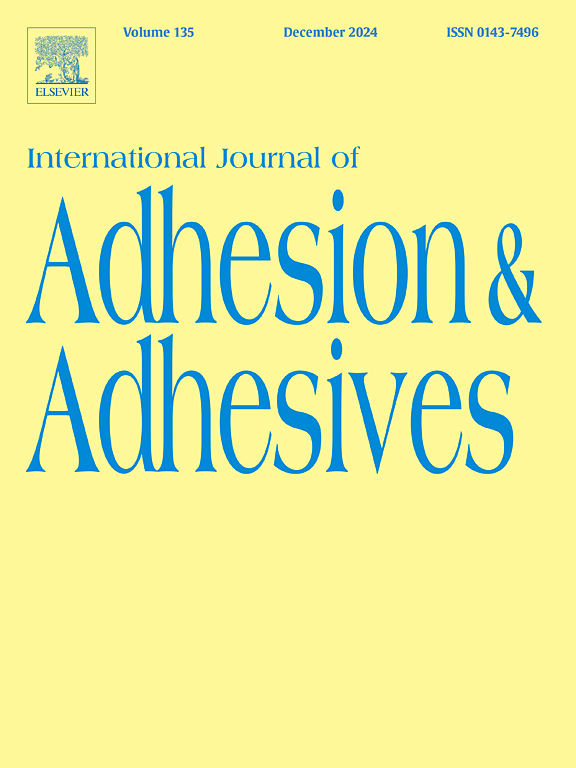关于 SPR 粘接铝钢板接缝疲劳特性的研究
IF 3.2
3区 材料科学
Q2 ENGINEERING, CHEMICAL
International Journal of Adhesion and Adhesives
Pub Date : 2024-10-22
DOI:10.1016/j.ijadhadh.2024.103864
引用次数: 0
摘要
本研究主要探讨了在搭接剪切几何形状下,粘合剂层对连接不同厚度 AlSi10MnMg 铝板和 DP590 钢板的自冲铆接(SPR)接头的疲劳行为和摩擦的影响。研究并比较了 SPR 和 SPR 粘合接头的疲劳寿命、失效模式、裂纹扩展和摩擦行为。结果表明,SPR 结合接头的静态强度和疲劳寿命明显高于 SPR 接头,但 SPR 结合接头和 SPR 接头的疲劳失效模式不同。SPR 粘合接头在所有测试载荷下均以铆钉尾部拉出模式失效,在较低的测试载荷下,与铆钉尾部接触的铝板会出现微小裂纹。然而,随着疲劳试验载荷的增加,SPR 接头的失效模式从铝板开裂转变为铆钉尾部拉出。而在铝板开裂失效过程中,疲劳裂纹源于铆钉柄附近的铝板和钢板交接处,并沿铝板宽度方向扩展。烧蚀磨损分析表明,由于粘合剂的粘合作用,烧蚀的总体程度有所降低,烧蚀区域的位置也各不相同。SPR 接头的烧蚀主要存在于距铆钉柄约 1.5 mm 的铝与钢的粘合界面上,并导致疲劳裂纹的产生,而 SPR 粘合接头的烧蚀区域则转移到了铆钉尾部与铝板的粘合界面上。本文章由计算机程序翻译,如有差异,请以英文原文为准。
Study on the fatigue properties of SPR-bonded aluminum-steel sheet joints
This study deals mainly with the influence of adhesive layer on the fatigue behavior and fretting of self-piercing riveted (SPR) joint joining differing thicknesses of AlSi10MnMg aluminum and DP590 steel sheets in lap shear geometry. Fatigue life, failure modes, crack propagation and fretting behaviors of the SPR and SPR-bonded joints were investigated and compared. The results showed that the static strength and fatigue life of SPR-bonded joints were significantly enhanced than that of SPR joints, but the fatigue failure mode of SPR-bonded and SPR joints differed. The SPR-bonded joints all failed in a rivet tail pull-out mode at all tested loads, which accompanied with small cracking in the aluminum sheet in contact with the rivet tail at lower test load. However, the failure mode of the SPR joints shifted from the aluminum sheet cracking to rivet tail pull-out as the fatigue test load increased. And during the aluminum sheet cracking failure, the fatigue crack originated from the faying interface of aluminum and steel sheet at the vicinity of the rivet shank and propagated along the width direction of aluminum sheet. Fretting wear analysis showed that the overall extent of fretting decreased and the location of fretting areas varied due to the adhesive bonding. Fretting of SPR joints mostly existed at the faying interface between aluminum and steel about 1.5 mm away from the rivet shank and resulted in fatigue crack initiation, while the fretting region of SPR-bonded joints shifted to the faying interface between rivet tail and aluminum sheet.
求助全文
通过发布文献求助,成功后即可免费获取论文全文。
去求助
来源期刊

International Journal of Adhesion and Adhesives
工程技术-材料科学:综合
CiteScore
6.90
自引率
8.80%
发文量
200
审稿时长
8.3 months
期刊介绍:
The International Journal of Adhesion and Adhesives draws together the many aspects of the science and technology of adhesive materials, from fundamental research and development work to industrial applications. Subject areas covered include: interfacial interactions, surface chemistry, methods of testing, accumulation of test data on physical and mechanical properties, environmental effects, new adhesive materials, sealants, design of bonded joints, and manufacturing technology.
 求助内容:
求助内容: 应助结果提醒方式:
应助结果提醒方式:


